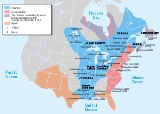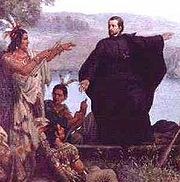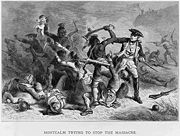
Franco-Indian alliance
Encyclopedia

Great Lakes
The Great Lakes are a collection of freshwater lakes located in northeastern North America, on the Canada – United States border. Consisting of Lakes Superior, Michigan, Huron, Erie, and Ontario, they form the largest group of freshwater lakes on Earth by total surface, coming in second by volume...
and the Illinois
Illinois
Illinois is the fifth-most populous state of the United States of America, and is often noted for being a microcosm of the entire country. With Chicago in the northeast, small industrial cities and great agricultural productivity in central and northern Illinois, and natural resources like coal,...
country during the French and Indian War
French and Indian War
The French and Indian War is the common American name for the war between Great Britain and France in North America from 1754 to 1763. In 1756, the war erupted into the world-wide conflict known as the Seven Years' War and thus came to be regarded as the North American theater of that war...
(1754–1763). The alliance involved French settlers on the one side, and the Abenaki, Ottawa
Ottawa
Ottawa is the capital of Canada, the second largest city in the Province of Ontario, and the fourth largest city in the country. The city is located on the south bank of the Ottawa River in the eastern portion of Southern Ontario...
, Menominee
Menominee
Some placenames use other spellings, see also Menomonee and Menomonie.The Menominee are a nation of Native Americans living in Wisconsin. The Menominee, along with the Ho-Chunk, are the only tribes that are indigenous to what is now Wisconsin...
, Winnebago
Ho-Chunk
The Ho-Chunk, also known as Winnebago, are a tribe of Native Americans, native to what is now Wisconsin and Illinois. There are two federally recognized Ho-Chunk tribes, the Ho-Chunk Nation of Wisconsin and Winnebago Tribe of Nebraska....
, Mississauga, Illinois
Illinois
Illinois is the fifth-most populous state of the United States of America, and is often noted for being a microcosm of the entire country. With Chicago in the northeast, small industrial cities and great agricultural productivity in central and northern Illinois, and natural resources like coal,...
, Sioux
Sioux
The Sioux are Native American and First Nations people in North America. The term can refer to any ethnic group within the Great Sioux Nation or any of the nation's many language dialects...
, Huron-Petun
Petun
The Petún , or Tionontati in their language, were an Iroquoian-speaking First Nations people closely related to the Wendat Confederacy. Their homeland was located along the southwest edge of Georgian Bay, in the area immediately to the west of the Huron territory in Southern Ontario of...
, Potawatomi
Potawatomi
The Potawatomi are a Native American people of the upper Mississippi River region. They traditionally speak the Potawatomi language, a member of the Algonquian family. In the Potawatomi language, they generally call themselves Bodéwadmi, a name that means "keepers of the fire" and that was applied...
etc... on the other. It allowed the French and the Indians to form a haven in the middle-Ohio valley before the open conflict between the European powers erupted.


New France
New France was the area colonized by France in North America during a period beginning with the exploration of the Saint Lawrence River by Jacques Cartier in 1534 and ending with the cession of New France to Spain and Great Britain in 1763...
in 1534. Acculturation and conversion were promoted, especially through the activities of the Jesuit missions in North America
Jesuit missions in North America
Jesuit missions in North America started during the 17th century and faltered at the beginning of the 18th. The missions were established as part of the colonial drive of France and Spain during the period, the "conquest of the souls" being an integral part of the constitution of Nouvelle-France...
. According to the 19th century historian Francis Parkman
Francis Parkman
Francis Parkman was an American historian, best known as author of The Oregon Trail: Sketches of Prairie and Rocky-Mountain Life and his monumental seven-volume France and England in North America. These works are still valued as history and especially as literature, although the biases of his...
:
French settlers moved southward to the Louisiana
Louisiana
Louisiana is a state located in the southern region of the United States of America. Its capital is Baton Rouge and largest city is New Orleans. Louisiana is the only state in the U.S. with political subdivisions termed parishes, which are local governments equivalent to counties...
, along the Ohio
Ohio
Ohio is a Midwestern state in the United States. The 34th largest state by area in the U.S.,it is the 7th‑most populous with over 11.5 million residents, containing several major American cities and seven metropolitan areas with populations of 500,000 or more.The state's capital is Columbus...
and the Mississippi
Mississippi
Mississippi is a U.S. state located in the Southern United States. Jackson is the state capital and largest city. The name of the state derives from the Mississippi River, which flows along its western boundary, whose name comes from the Ojibwe word misi-ziibi...
valleys. France allied with the majority of the First Nations in North American, with the intent of defeating the British. According to one observer:


Louis-Joseph de Montcalm
Louis-Joseph de Montcalm-Gozon, Marquis de Saint-Veran was a French soldier best known as the commander of the forces in North America during the Seven Years' War .Montcalm was born near Nîmes in France to a noble family, and entered military service...
assembled a force of 6,000 regulars and 2,000 Indians in the Battle of Fort William Henry
Battle of Fort William Henry
The Siege of Fort William Henry was conducted in August 1757 by French General Louis-Joseph de Montcalm against the British-held Fort William Henry...
.
In 1759, as Britain had a string of successes, especially with the Battle of Fort Niagara
Battle of Fort Niagara
The Battle of Fort Niagara was a siege late in the French and Indian War, the North American theatre of the Seven Years' War. The British siege of Fort Niagara in July 1759 was part of a campaign to remove French control of the Great Lakes and Ohio Valley regions, making possible a western invasion...
, the French were unable to properly supply and support their Indian allies, and the Franco-Indian alliance started to unravel. At the same time, the British were making promises of support and protection to the Indians. Finally Quebec fell in September in the Battle of the Plains of Abraham
Battle of the Plains of Abraham
The Battle of the Plains of Abraham, also known as the Battle of Quebec, was a pivotal battle in the Seven Years' War...
.
Long after the extinction of New France
New France
New France was the area colonized by France in North America during a period beginning with the exploration of the Saint Lawrence River by Jacques Cartier in 1534 and ending with the cession of New France to Spain and Great Britain in 1763...
in 1763, Franco-Indian communities would persist, practicing the catholic faith, speaking French and using French names. From the Saint Lawrence
Saint Lawrence
Lawrence of Rome was one of the seven deacons of ancient Rome who were martyred during the persecution of Valerian in 258.- Holy Chalice :...
to the Mississippi
Mississippi
Mississippi is a U.S. state located in the Southern United States. Jackson is the state capital and largest city. The name of the state derives from the Mississippi River, which flows along its western boundary, whose name comes from the Ojibwe word misi-ziibi...
, cosmopolitan French communities accommodated Indians and Blacks
Blacks
Blacks may refer to:* All Blacks, New Zealand rugby union team* Black people* Blacks Leisure Group, owner of Blacks and Millets in the United Kingdom* The Blacks , a play by Jean Genet* Zamora, California, formerly called Blacks...
.
During the American War of Independence and the onset of the Franco-American alliance
Franco-American alliance
The Franco-American alliance refers to the 1778 alliance between Louis XVI's France and the United States, during the American Revolutionary War. Formalized in the 1778 Treaty of Alliance, it was a military pact in which France provided arms and money, and engaged in full-scale war with Britain. ...
, the French would again combine with Indian troops, as in the Battle of Kiekonga in 1780 under Augustin de La Balme
Augustin de La Balme
Augustin Mottin de la Balme was a French cavalry officer who served in Europe during the Seven Years War and in the United States during the American Revolution...
.

